There's a lot of hype out there about the flight between Dushanbe and Khorog, with breathless claims about how dangerous and terrifying it is, and how the plane routinely comes dangerously close to the sides of mountains as it flies between them and not above them. You'll even read about how, despite there not being any crashes involving this flight, there have been instances where the wingtips have actually brushed up against the mountains, dusting the snow off them. That the flight only runs on days when they can confirm at both ends that the weather is clear, and the mountains they fly between clearly visible, only serves to confirm the notoriety of this segment.
But first things first: I had to actually get to the airport in the morning and hope for good weather so the flight could be confirmed. The time printed on the ticket was 6:30, and I figured that it would be a good idea to show up early. You know, like people do in most airports. I thought this would be an especially good idea since I had heard that despite tickets not being sold until the evening before a flight, there were sometimes more tickets sold than seats available if earlier flights had been cancelled due to bad weather.
I took one of the first-running trolley buses from the Farhang to the airport, and made my way to the domestic terminal, which is actually just a large room off to the left of the main terminal, with a separate entrance and a few counters. The terminal was open when I arrived around 5:15, but people were just milling around and they were not waiting for the flight to Khorog. I was pretty sure of this as I didn't see my friend from the day before.
At around 5:45, once the flight those people were assembled for had left, they closed the terminal and kicked me out, making me wait outside. This wasn't that bad, as I fired up my netbook and discovered that the flagship Megafon telecom store, located in the international terminal, had an open wi-fi connection that was extremely fast (a rarity in Central Asia outside of Kazakhstan). I took the opportunity to download a bunch of movies as I waited for things to get cooking.
It wasn't until the actual indicated departure time that people began showing up, and even as they began to gather in the square outside, the terminal still didn't open up. When it did open up the entire check-in process was remarkably relaxed and surprisingly informal. They have a 10 kg weight limit on luggage, and I ended up paying an extra 10 somoni for being a kilogram over. What was more surprising was how many people who showed up who weren't taking the flight, and were also not related to any of the passengers—they were there to ask them to take things to their friends or relatives in Khorog. Obviously this would be a big no-no from a security perspective in the West, and those who buy into the idea that Badakshan is a restive area filled with potential terrorists might also balk at the idea, but my Pamiri friend said that pretty much everyone would agree to do this as it serves an important function in facilitating the transfer of important items. He himself accepted a car part that someone would be waiting for in Khorog. Given the standards of hospitality in the area, none of this should be particularly surprising.
After getting everyone checked in an passing through the rudimentary security, we went out on the tarmac to the plane. You enter at the rear through bomb-bay doors and a little ladder, and inside there are five rows of seats, with single seats on the left of the aisle and benches that seat two (or three) on the right. The seats are little fold-down benches of the sort that might have appeared in cheap post-war cars, but which are more akin to lawn furniture than modern seats. I first picked the first seat on the left, but later asked my Pamiri friend if I could switch with him when I noticed that my window was cracked and scratched and practically impossible to see out of. Since he had taken this flight a number of times, I thought he wouldn't mind, and I was able to get his window seat on the right side.
The seats don't have seat belts—not that it would matter that much—and parents kept their kids in their laps or let them sprawl over the backs of the benches. Again, similar to post-war driving culture, before we cared about things like padded dashes, seat-belts, and car seats for kids, let alone air bags and the like.
 |
| We ended up taking off at about 9:15. This flat agricultural land was just outside Dushanbe. |
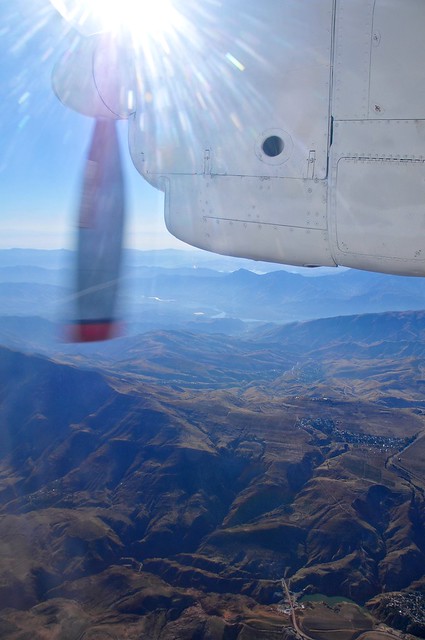 |
| The views on the right on the Dushanbe-Khorog leg are meant to be the best, but at this time of year you get a face full of glare from the sun, and hazy views from the smog, making views from the left side much clearer, if less spectacular. In the summer the sun would be much higher and less problematic, and in the later Khorog-Dushanbe flight it would also be less objectionable. |
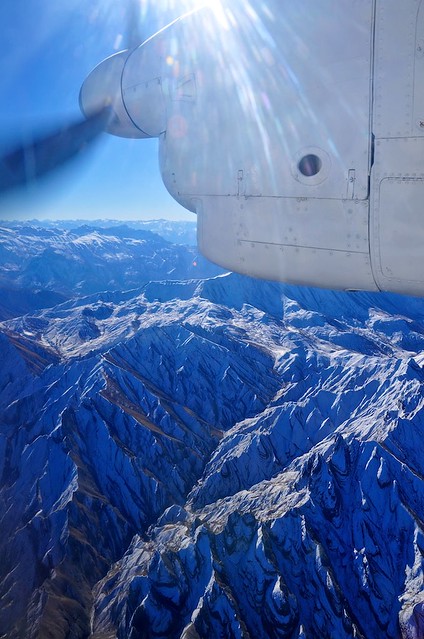 |
| Low mountains are already covered with snow. I know they're low because the plane apparently doesn't go above 4,200 meters. |
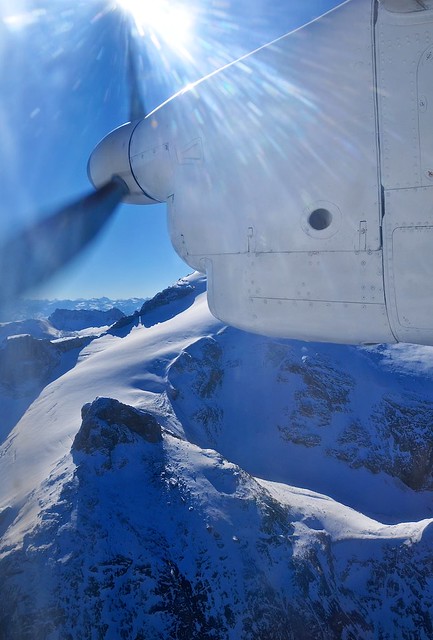 |
| The mountains are getting higher, but we're still above them. |
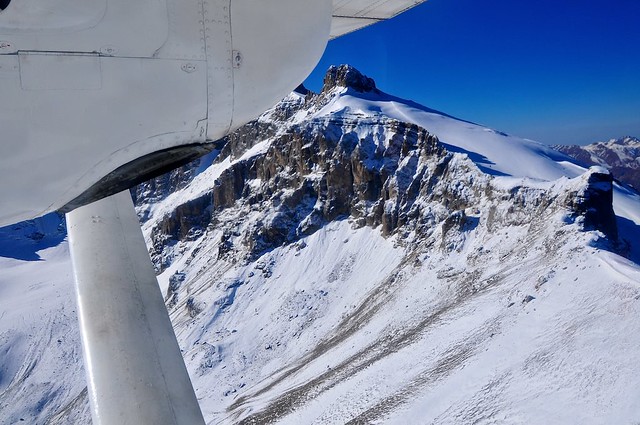 |
| Okay, maybe we're flying between mountains now, but it's not the terrifying experience others have made it out to be: we're definitely a good distance from any mountains. |
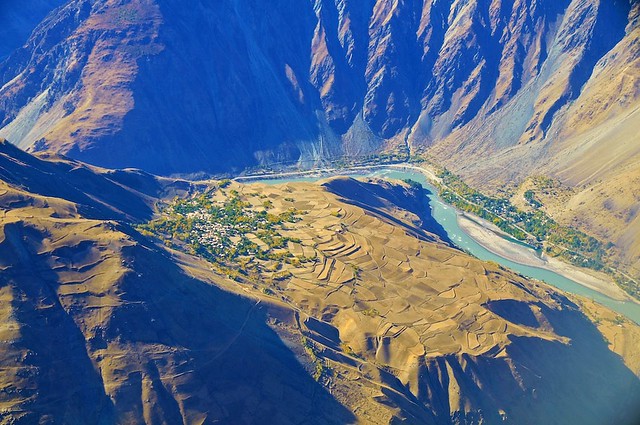 |
| Looking down at a mountain-side village. |
 |
| Back into the mountains. |
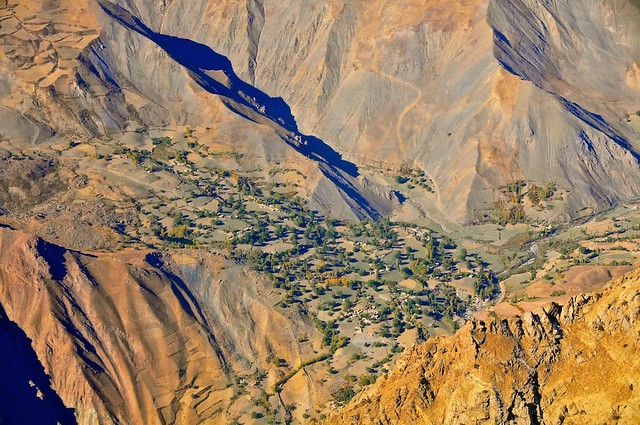 |
| And more villages. The population density doesn't make much more sense from the air, as there really aren't many hidden plots of land that wouldn't be visible from the ground which might support all these people. |
 |
| More low mountains. |
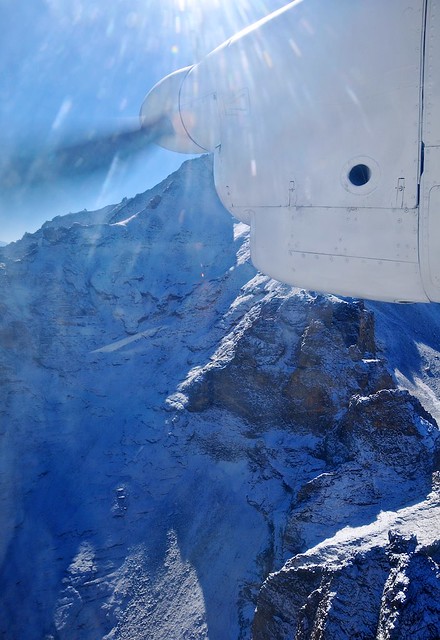 |
| Now we're getting to higher mountains. |
 |
| This is about as close to the sides of mountains as we got. They look closer than they are, mainly because they're so big. |
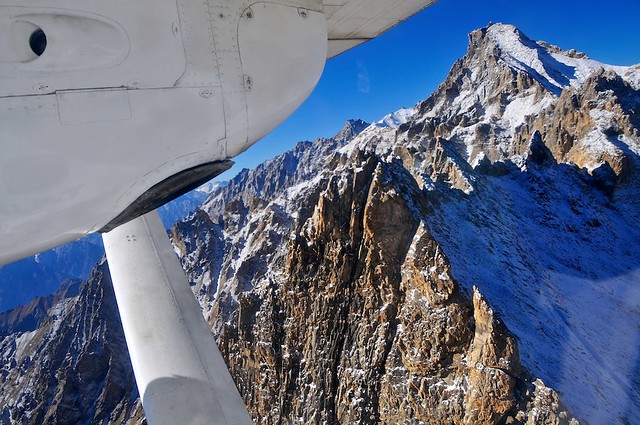 |
| As close a call as you're going to get. And after this pass, the route doesn't come particularly close to any mountains, but flies down the middle of a relatively wide valley. |
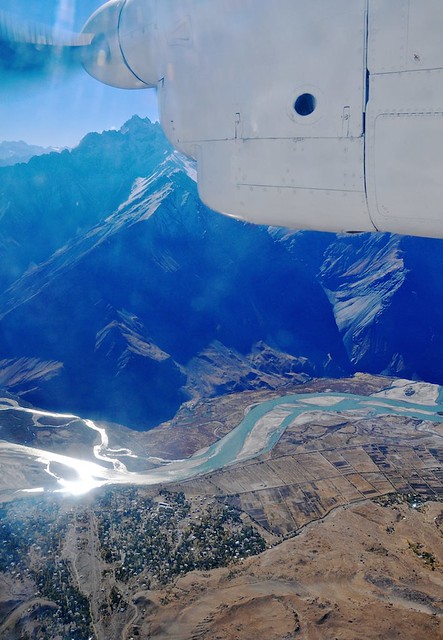 |
| A village just to the west of Rushan welcomes us out of the final mountain pass. |
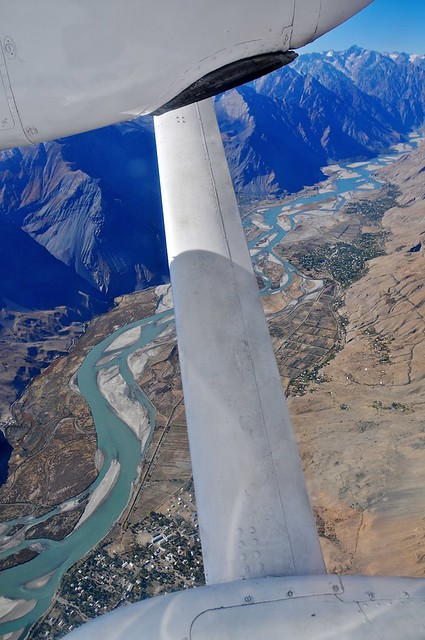 |
| We join up with the M41 and Pyanj river here, then follow the river and highway down to Khorog. Tajikistan is on the right, while it's Afghanistan across the river to the left. |
 |
| Looking west along the Pyanj, which makes a 90° turn in Rushan (the plane is headed down the Pyanj Valley towards Khorog). |
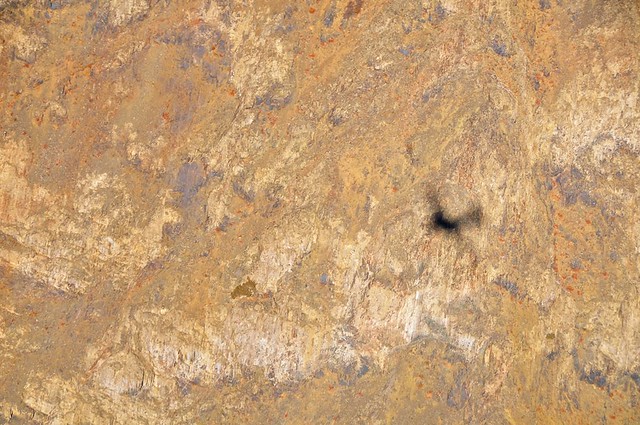 |
| Close enough to the mountains to cast a coherent shadow. |
 |
| Fields on the side of a mountain. |
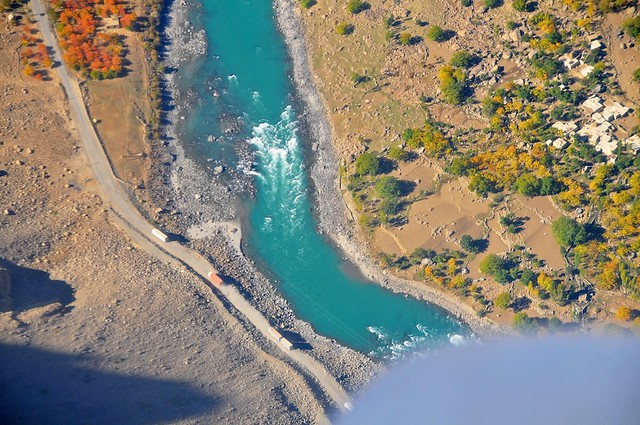 |
| Trucks (probably Chinese) ply the M41, with Afghanistan on the right. |
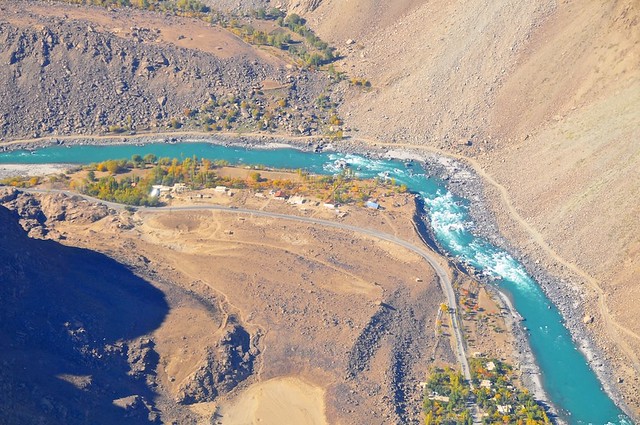 |
| As bad as the M41 is, the roads on the Afghan side look just a tad worse. |
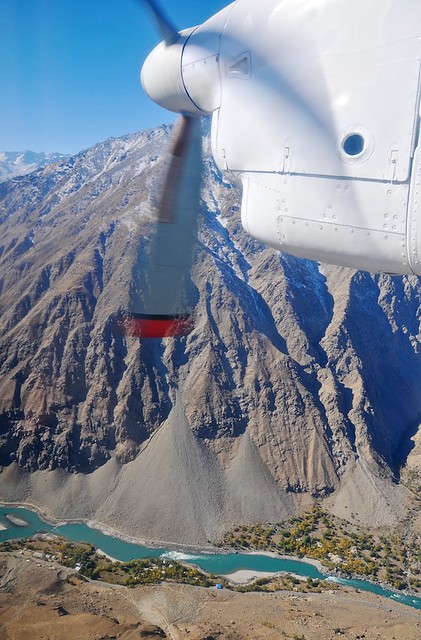 |
| I'm surprised landslides never dam the river and wash out the valley. |
 |
| Growing up near the Alberta Rockies, I'm used to glacier-fed rivers that look like this; the trees and houses, not so much. |
 |
| View across the Pyanj and into Afghanistan. |
 |
| Nose down on our approach to Khorog. |
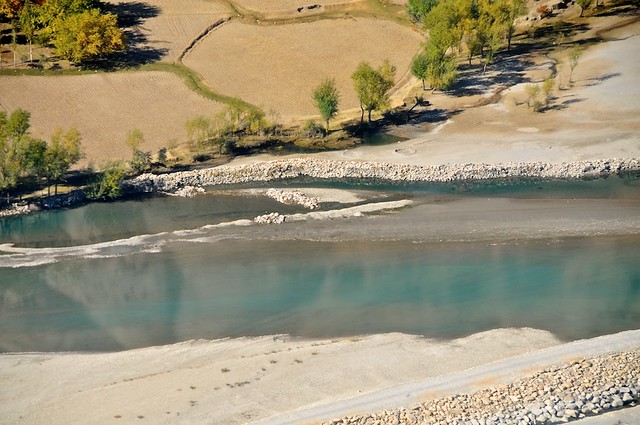 |
| Afghanistan across the river: so close and so far. |
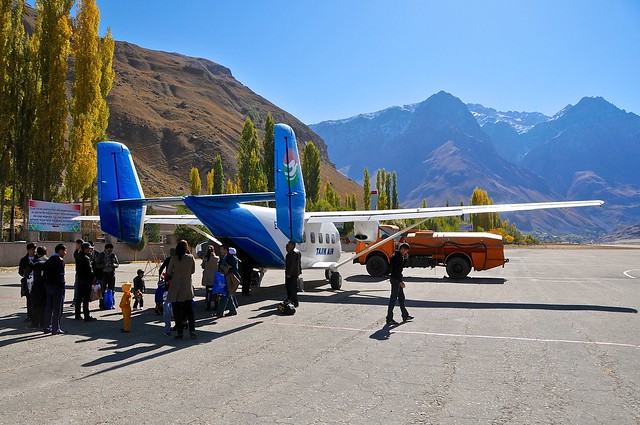 |
| Looking south just after deplaning from our Antonov An-28. We arrived just after 10:30, and Khorog is only a few kilometers away in the side-valley on the left: still a full day left to explore. |
 |
| Looking west across the river into Afghanistan. |
 |
| Locals walking down the runway on their way home. |
Once on the ground, I went through the "terminal," where I saw some passengers handing off cargo to people waiting for it, then made my way outside to try and figure out how to get to Khorog. I had no idea how far town was—or even what direction it was—and to my surprise there were no taxi touts whose offers I had to shoot down, nor was there really any organized transport waiting for locals. I guess a flight for 15 people doesn't generate a lot of need, especially when most probably have family or friends to greet them. But based on where people were walking and where their friends and relatives were driving them, it didn't take too long to figure out that I needed to head south to get into town, and I set off on foot.
The walk into town actually isn't that long, and you pass a market as you enter the side valley in which Khorog nestles. I stopped there to take a brief look (big and colourful Pamiri socks seem to be a popular item), then headed into town and made my way across the river and up to
Lalmo's Homestay, which had been recommended to me by an
older Australian lady I met in Hohhot three months earlier (solid advice, as her homestay is one of the best I've stayed at and she's very friendly and helpful).
The bottom line: not all it's made out to be, but interesting and a definite time saver
The price of the ticket seems to be pretty stable at about $95 (I paid 440 somoni, plus 10 extra for being over the weight limit, which was about $95 in total at 2012 exchange rates). Given that it gets you to Khorog by 10:30, and that a share vehicle generally takes at least 16 hours of sitting in a cramped position, it's definitely worth trying to get a ticket. This is especially so given that the price in a share taxi isn't much cheaper, and can even be more expensive depending on the season.
During the summer and peak season, it's worth sitting on the right hand side as you fly from Dushanbe to Khorog, but in the fall and spring it may give you a lot of glare and intensify the haze and pollution. On the later flight from Khorog to Dushanbe, it probably always a good idea to sit on the left. Try to be one of the first to board, and quickly scan the plane for a seat with a clear window: some of the windows are so scratched up and hazy that they look like frosted glass: views will be impossible.




























Thank you for sharing your travel experiences. I am thinking about going. Appreciate the tips!
ReplyDeleteGlad it was useful. It seems like Tajikistan and the Pamirs are becoming more and more popular, which probably makes it even more difficult to get a ticket today (especially considering when I went the Pamirs had only recently opened back up to tourists, so there weren't many people there).
ReplyDelete